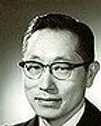Activity 5.1: Who was the First Asian American to Command a U.S. Battalion?
Activity 5.1: Who was the First Asian American to Command a U.S. Battalion?
Activity 5.1: Who was the First Asian American to Command a U.S. Battalion?

Students explore the life of Young Oak Kim (pictured to the left in high high school graduation photo) and identify contributions he has made to the United States. They complete a Think/Write/Pair Share/Group Share as they reflect on what it is like to be a Korean American/minority struggling through racial barriers like Young Kim. They also have the opportunity to explore racism and microagressions.
Young Oak Kim in 1961. (Source: WIkipedia)
Activity Questions
- Who was Young Oak Kim?
- Who was the first Asian American to command a U.S. battalion?
- Col. Young Oak Kim’s story demonstrates how racism permeated even the U.S. military. How did Young Oak Kim combat racism? What lessons about racism can we learn from his story?
- What contributions did Young Oak Kim make to his community and the United States?
- How do contributions of Asian American and Pacific Islanders, such as Colonel Young Oak Kim, help us understand how ethnic minorities are treated in the United States military and as civilians?
- Why is it important to learn about diversity, immigrants and racism in the United States?
Instructional Strategies
- Use the Lesson 5: Young Oak Kim: Hero and Humanitarian (Activity 5.1) presentation to support this lesson.
Introductory Activity
- Ask students to share encounters with racial discrimination or microaggressions. Use the slide, How Have You Encountered Racism or Microaggressions? to be sure students understand the definitions of these terms. An optional additional slide, Tips for Responding to Microaggressions, is provided and may be added to the lesson as appropriate. In addition, see the PDF article, Responding to Microaggressions and Bias, under resources.
Introduction to Young Oak Kim
- After the discussion, ask students what they know about Colonel Young Oak Kim. On the board, start a Class Reflective Journal (What We Know; How We Felt; What We Learned). With the class, fill out the What We Know section and write their responses (for example: “Korean person; never heard of him; etc.”). This is similar to a KWL activity and will let the teacher know how much (or little) students know about him.
- Review the Activity Questions. Inform students they are going to learn about Young Oak Kim and how he responded to racism and microaggressions.
- Present basic information about Young Oak Kim and the Korean American community through the following resources. As students view the resources, have them take notes and highlight segments of text about moments where Kim encountered racism or microaggressions.
- Colonel Young Oak Kim video (4:29 minutes)
- Web Article: Young Oak Kim (100th Infantry Battalion Veterans Education Center)
- Young Oak Kim Interactive Map
- Quick Fact Sheet on Colonel Young Oak Kim
Discussion
- Lead a discussion about racism and immigration in the U.S., focusing on the essential questions. Ask students to think about how racism is not just something that happens on the streets, but permeates even the military, as Colonel Young Oak Kim experienced. Ask students to consider how Young Oak Kim overcame racial divides during his life.
Going Deeper
- Play the interview of Colonel Young Oak Kim by the Go For Broke Monument in Los Angeles. As students listen, have them consider how Kim developed his Korean American identity and overcame ethnic boundaries and racism. As students watch, they should consider what it is like to be a Korean American/minority struggling through racial barriers like Young Oak Kim did.
Closing Activity
- Close the lesson with a Think Write Pair/Share Group Share OR by completing the remaining sections (How We Felt; What We Learned) of the chart provided in the Introductory Activity.
- OPTIONAL: Use the additional slide, Tips for Responding to Microaggressions, and the PDF article, Responding to Microaggressions and Bias, to support discussion of how students might respond to microaggressions and bias.
Resources
- Lesson 5 Teacher’s Guide
- Lesson 5 Presentation
- Handout: Quick Facts Young Oak Kim
- Interactive Map Tour: Young Oak Kim: The Journey of an Unsung American Hero and Tireless Public Servant
- Video: Colonel Young Oak Kim
- Web Article: Young Oak Kim
- Article: Responding to Microaggressions and Bias
- Additional videos of Young Oak Kim, Oral History Interview (parts 1-7) are archived at USC Digital Library.
Quick Facts Young Oak Kim (PDF)
YouTube Video: Colonel Young Oak Kim (4:29 minutes)

